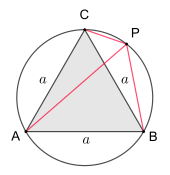Van Schooten's theorem
The set of van Schooten , named after the mathematician Dutch Frans van Schooten is a theorem of the triangle geometry says that the following:
- Given is an equilateral triangle of the Euclidean plane with the three corner points and a point of the circumference of .
- Without loss of generality, let the largest of the three route lengths , i.e. H. lies on the arc that connects and .
- Then applies .
The theorem is a simple consequence of Ptolemy's theorem , according to which the product of the lengths of the diagonals in a chordal quadrilateral is equal to the sum of the products of the lengths of the opposite sides. If you apply this to the quadrilateral tendon in the adjacent sketch, you get
But since the triangle is equilateral, it holds and one obtains
If one divides this equation by the length of the side , one obtains the claim of van Schooten's theorem.
literature
- Hermann Athens, Jörn Bruhn (ed.): Lexicon of school mathematics and related areas. Band 4 - S to Z . Aulis Verlag , Cologne 1978, ISBN 3-7614-0242-2 .
- Claudi Alsina, Roger B. Nelsen: Enchanting Evidence. A journey through the elegance of mathematics . Springer Verlag , Berlin [u. a.] 2013, ISBN 978-3-642-34792-4 .
- Jozsef Sandor: On the Geometry of Equilateral Triangles . Forum Geometricorum, Volume 5 (2005), pp. 107-117
Web links
Commons : Van Schooten's theorem - collection of images, videos and audio files
- Sentence by van Schooten on cut-the-knot.org
Individual evidence
- ^ Hermann Athen, Jörn Bruhn (ed.): Lexicon of school mathematics and adjacent areas. Band 4 - S to Z . tape 4 . Aulis Verlag , Cologne 1978, ISBN 3-7614-0242-2 , p. 933 .
- ↑ Claudi Alsina, Roger B. Nelsen: Enchanting Evidence. A journey through the elegance of mathematics . Springer Verlag , Berlin [u. a.] 2013, ISBN 978-3-642-34792-4 , pp. 118 ff .













